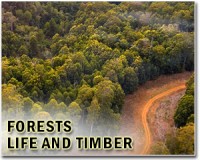| . |  |
. |
Washington DC (SPX) Apr 06, 2010 An Agricultural Research Service (ARS) scientist participated in a project to fine-tune computer models that can indicate when forest "carbon sinks" become net carbon generators instead. The results will help pinpoint the effectiveness of trees in offsetting carbon releases that contribute to higher atmospheric temperatures and global climate change. ARS plant physiologist Erik Hamerlynck teamed up with Rutgers University biologist Karina Schafer and U.S. Forest Service colleagues Kenneth Clark and Nicholas Skowronski to calibrate the Canopy Conductance Constrained Carbon Assimilation (4C-A) model, a computer program that generates carbon balance estimates for tree canopies. Hamerlynck works at the ARS Southwest Watershed Research Center in Tucson, Ariz. In the summer of 2006, the team measured tree sap flow and leaf-level photosynthetic gas exchange at different canopy levels in a stand of oaks and pines in the New Jersey Pine Barrens. These data were used to calibrate the 4C-A model to simulate the amount of carbon the tree canopy absorbs and releases into the atmosphere via photosynthesis and respiration. Results from the calibrated model-which were within 15 percent of estimates from three other techniques-indicated that the average seasonal carbon absorption of the stand was around 1,240 grams of carbon per square meter of canopy area. The scientists then used the 4C-A model to estimate seasonal carbon exchange rates for 2007, when the same stand of trees was completely defoliated for 2 to 3 weeks during an infestation of gypsy moths. This infestation occurred when the stand was at its seasonal peak for carbon uptake. The model showed that after the gypsy moths had finished foraging, the average carbon absorption rates for the growing season dropped 25 percent to around 940 grams of carbon per square meter of canopy area. This decline meant that the stand was no longer a net carbon "sink"-it ended up adding more carbon back to the atmosphere than it had absorbed. According to the U.S. Forest Service, U.S. forests absorb and store about 750 million metric tons of carbon dioxide each year. Managing forest resources to optimize carbon sequestration is essential in mitigating the effects of climate change. Results from this work were published in Global Change Biology. USDA is an equal opportunity provider, employer and lender. To file a complaint of discrimination, write: USDA, Director, Office of Civil Rights, 1400 Independence Ave., S.W., Washington, D.C. 20250-9410 or call (800) 795-3272 (voice), or (202) 720-6382 (TDD).
Share This Article With Planet Earth
Related Links United States Department of Agriculture-Research, Education, and Economics Forestry News - Global and Local News, Science and Application
 Chinese plywood boss stopped from leaving Gabon
Chinese plywood boss stopped from leaving GabonLibreville (AFP) March 30, 2010 Gabon authorities have barred the Chinese buyer of an former European plywood giant from leaving the country, an official said Tuesday, as the France-based company battles legal and financial problems. Guohua Zhang, head of the Chinese group Honest Timber which bought out Plysorol last year, was briefly held last week because his identity papers were "false", a senior documentation and immig ... read more |
|
| The content herein, unless otherwise known to be public domain, are Copyright 1995-2010 - SpaceDaily. AFP and UPI Wire Stories are copyright Agence France-Presse and United Press International. ESA Portal Reports are copyright European Space Agency. All NASA sourced material is public domain. Additional copyrights may apply in whole or part to other bona fide parties. Advertising does not imply endorsement,agreement or approval of any opinions, statements or information provided by SpaceDaily on any Web page published or hosted by SpaceDaily. Privacy Statement |